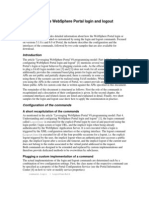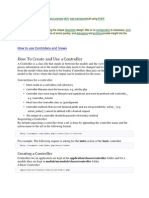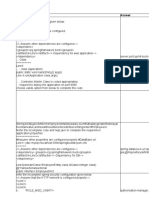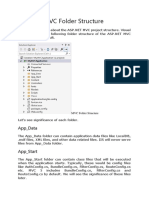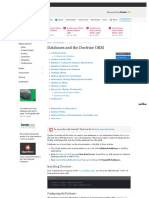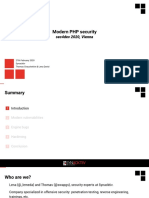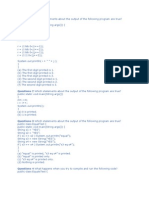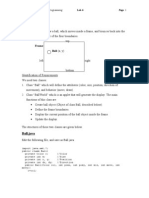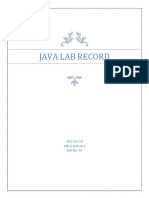Lumen 5.5 Doc Excerpt
Lumen 5.5 Doc Excerpt
Uploaded by
shambalicCopyright:
Available Formats
Lumen 5.5 Doc Excerpt
Lumen 5.5 Doc Excerpt
Uploaded by
shambalicOriginal Title
Copyright
Available Formats
Share this document
Did you find this document useful?
Is this content inappropriate?
Copyright:
Available Formats
Lumen 5.5 Doc Excerpt
Lumen 5.5 Doc Excerpt
Uploaded by
shambalicCopyright:
Available Formats
Lumen 5.
5 ☰
HTTP Controllers
# Introduction
# Basic Controllers
# Controller Middleware
# Dependency Injection & Controllers
# Introduction
Instead of defining all of your request handling logic in a single routes . php file, you may wish to organize this behavior
using Controller classes. Controllers can group related HTTP request handling logic into a class. Controllers are stored in
the app / Http / Controllers directory.
# Basic Controllers
Here is an example of a basic controller class. All Lumen controllers should extend the base controller class included with
the default Lumen installation:
<?php
namespace App \ Http \ Controllers ;
use App \ User ;
class UserController extends Controller
/**
* Retrieve the user for the given ID.
* @param int $id
* @return Response
*/
public function show ( $id )
return User :: findOrFail ( $id ) ;
We can route to the controller action like so:
$router - > get ( 'user/{id}' , 'UserController@show' ) ;
Now, when a request matches the specified route URI, the show method on the UserController class will be executed. Of
course, the route parameters will also be passed to the method.
Controllers & Namespaces
It is very important to note that we did not need to specify the full controller namespace when defining the controller route.
We only defined the portion of the class name that comes a er the App\ Http \ Controllers namespace "root". By default,
the bootstrap / app . php file will load the routes . php file within a route group containing the root controller namespace.
If you choose to nest or organize your controllers using PHP namespaces deeper into the App\ Http \ Controllers
directory, simply use the specific class name relative to the App\ Http \ Controllers root namespace. So, if your full
controller class is App\ Http \ Controllers \ Photos \ AdminController , you would register a route like so:
$router - > get ( 'foo' , 'Photos\AdminController@method' ) ;
Naming Controller Routes
Like Closure routes, you may specify names on controller routes:
$router - > get ( 'foo' , [ 'uses' = > 'FooController@method' , 'as' = > 'name' ] ) ;
You may also use the route helper to generate a URL to a named controller route:
$url = route ( 'name' ) ;
# Controller Middleware
Middleware may be assigned to the controller's routes like so:
$router - > get ( 'profile' , [
'middleware' = > 'auth' ,
'uses' = > 'UserController@showProfile'
]);
However, it is more convenient to specify middleware within your controller's constructor. Using the middleware method
from your controller's constructor, you may easily assign middleware to the controller. You may even restrict the
middleware to only certain methods on the controller class:
class UserController extends Controller
/**
* Instantiate a new UserController instance.
*
* @return void
*/
public function __construct ( )
{
$this - > middleware ( 'auth' ) ;
$this - > middleware ( 'log' , [ 'only' = > [
'fooAction' ,
'barAction' ,
]]);
$this - > middleware ( 'subscribed' , [ 'except' = > [
'fooAction' ,
'barAction' ,
]]);
# Dependency Injection & Controllers
Constructor Injection
The Lumen service container is used to resolve all Lumen controllers. As a result, you are able to type-hint any
dependencies your controller may need in its constructor. The dependencies will automatically be resolved and injected
into the controller instance:
<?php
namespace App \ Http \ Controllers ;
use App \ Repositories \ UserRepository ;
class UserController extends Controller
/**
* The user repository instance.
*/
protected $users ;
/**
* Create a new controller instance.
*
* @param UserRepository $users
* @return void
*/
public function __construct ( UserRepository $users )
$this - > users = $users ;
Method Injection
In addition to constructor injection, you may also type-hint dependencies on your controller's action methods. For example,
let's type-hint the Illuminate\ Http \ Request instance on one of our methods:
<?php
namespace App \ Http \ Controllers ;
use Illuminate \ Http \ Request ;
class UserController extends Controller
/**
* Store a new user.
*
* @param Request $request
* @return Response
*/
public function store ( Request $request )
{
$name = $request - > input ( 'name' ) ;
//
}
If your controller method is also expecting input from a route parameter, simply list your route arguments a er your other
dependencies. For example, if your route is defined like so:
$router - > put ( 'user/{id}' , 'UserController@update' ) ;
You may still type-hint the Illuminate\ Http \ Request and access your route parameter id by defining your controller
method like the following:
<?php
namespace App \ Http \ Controllers ;
use Illuminate \ Http \ Request ;
class UserController extends Controller
{
/**
* Update the specified user.
* @param Request $request
* @param string $id
* @return Response
*/
public function update ( Request $request , $id )
//
Laravel is a trademark of Taylor Otwell. Copyright © Taylor Otwell.
Design by Jack McDade.
You might also like
- Symfony - Certification BookDocument292 pagesSymfony - Certification BookMǝhdi Borealis100% (3)
- The Healing Gods Complementary and Alternative Medicine in Christian AmericaDocument337 pagesThe Healing Gods Complementary and Alternative Medicine in Christian Americashambalic83% (6)
- GurdjieffDocument295 pagesGurdjieffkata100% (9)
- React Quickstart Step Guide PDFDocument188 pagesReact Quickstart Step Guide PDFshambalic100% (6)
- Laravel Part-3Document10 pagesLaravel Part-3waver58650No ratings yet
- 12-Middleware - Laravel - The PHP Framework For Web ArtisansDocument6 pages12-Middleware - Laravel - The PHP Framework For Web ArtisansMomo SemerkhetNo ratings yet
- 07-Service Container - Laravel - The PHP Framework For Web ArtisansDocument7 pages07-Service Container - Laravel - The PHP Framework For Web ArtisansLabel ExcellenceNo ratings yet
- Laravel Part-9Document12 pagesLaravel Part-9waver58650No ratings yet
- Lesson 1 - Laravel API CRUD Best PracticeDocument12 pagesLesson 1 - Laravel API CRUD Best PracticeAntonius AjalahNo ratings yet
- Laravel Cheat Sheet & Quick ReferenceDocument47 pagesLaravel Cheat Sheet & Quick ReferenceMostafa MirbabaieNo ratings yet
- Multi Guard Authentication in Laravel 5.8Document6 pagesMulti Guard Authentication in Laravel 5.8Dinesh SutharNo ratings yet
- ControllersDocument14 pagesControllersrobim60752No ratings yet
- Lecture 3Document1 pageLecture 3waver58650No ratings yet
- REST Overview: Identifying A ResourceDocument21 pagesREST Overview: Identifying A ResourceJeevan ReddyNo ratings yet
- 1.1 Laravel PDFDocument10 pages1.1 Laravel PDFjande0115194No ratings yet
- Project Overview: PHP FrameworksDocument31 pagesProject Overview: PHP FrameworksSOHEL RANA Spring 19No ratings yet
- Spring Boot Notes:: List of AnnotationsDocument9 pagesSpring Boot Notes:: List of Annotationsmukul_manglaNo ratings yet
- 03 Laravel ResponsesDocument5 pages03 Laravel Responsesttooffee23No ratings yet
- Easy Web Services Using PHP Reflection 1229096730084678 1Document21 pagesEasy Web Services Using PHP Reflection 1229096730084678 1Carlos FuentealbaNo ratings yet
- Silex Cheat Sheet v1 PDFDocument17 pagesSilex Cheat Sheet v1 PDFpAt0h2No ratings yet
- Laravel 11 REST API CRUD With Best Practices - by Sandalanka - Mar, 2024 - MediumDocument19 pagesLaravel 11 REST API CRUD With Best Practices - by Sandalanka - Mar, 2024 - MediumAntonius AjalahNo ratings yet
- LaravelDocument4 pagesLaravelpiru1No ratings yet
- Customizing WP Login and Logout CommandsDocument10 pagesCustomizing WP Login and Logout CommandsKaran AggarwalNo ratings yet
- 5 - PHP Framework Part 1-MTDDocument35 pages5 - PHP Framework Part 1-MTDRIFQAH AMALIYAHNo ratings yet
- spring important annotationsDocument8 pagesspring important annotationsmanuel.ballesterosNo ratings yet
- Kohana DocumentaionDocument52 pagesKohana DocumentaionkranthiNo ratings yet
- Create Custom REST API in Magento 2-Check CodeDocument32 pagesCreate Custom REST API in Magento 2-Check Codegiangndph25717No ratings yet
- Accenture DumpsDocument23 pagesAccenture Dumpsmamidi sudeep100% (2)
- Authentication LaravelDocument15 pagesAuthentication LaravelAlin GheorghitaNo ratings yet
- Laravel Beginners Full CourseDocument56 pagesLaravel Beginners Full CoursebusrazcvikNo ratings yet
- Spring Boot s1Document22 pagesSpring Boot s1Hedir Ben MoussaNo ratings yet
- App - Data: MVC Folder StructureDocument36 pagesApp - Data: MVC Folder StructurepepaNo ratings yet
- Purpose of Global - AsaxDocument7 pagesPurpose of Global - Asaxali.fatmiNo ratings yet
- Write a PHP program to create a url shortener laravel (1)Document5 pagesWrite a PHP program to create a url shortener laravel (1)sansukushwaha81209926No ratings yet
- MVC EssentialsDocument52 pagesMVC EssentialsVassil VassilevNo ratings yet
- Zend Concept UnderstandingDocument4 pagesZend Concept UnderstandingPritesh RabariNo ratings yet
- ControllerDocument7 pagesControllerjobs.vipul711No ratings yet
- How To Create A Secure CRUD RESTful API in Laravel 8 and 7 Using Laravel Passport - DEV CommunityDocument26 pagesHow To Create A Secure CRUD RESTful API in Laravel 8 and 7 Using Laravel Passport - DEV CommunityAntonius Ajalah0% (1)
- Real TimeDocument14 pagesReal TimeYu WaNo ratings yet
- Test 2Document4 pagesTest 2Fajrul akbar ZuhdiNo ratings yet
- Quickstart - Flask Documentation (3.0.x)Document20 pagesQuickstart - Flask Documentation (3.0.x)myawnNo ratings yet
- Write Your Own PHP MVC FrameworkDocument20 pagesWrite Your Own PHP MVC Frameworkzubair90No ratings yet
- WordPress y La API REST Usando WordPress Como Gestor de Contenidos en Aplicaciones ExternasDocument71 pagesWordPress y La API REST Usando WordPress Como Gestor de Contenidos en Aplicaciones Externasjuan perezNo ratings yet
- API PHP Package - MikroTik WikiDocument12 pagesAPI PHP Package - MikroTik Wikigustavito92012420945No ratings yet
- Installation: Available Command OptionsDocument3 pagesInstallation: Available Command OptionsCamilo VargasNo ratings yet
- Servlets Writing FiltersDocument3 pagesServlets Writing FiltersPawan KumarNo ratings yet
- Spring BootDocument10 pagesSpring Bootrahul satsangiNo ratings yet
- MaterialDocument12 pagesMaterialYash BhiseNo ratings yet
- Unit - V Spring RESTDocument30 pagesUnit - V Spring RESTm.saimohan2020No ratings yet
- Loopback4-Authentication - NPMDocument65 pagesLoopback4-Authentication - NPMUTIL DesarrollosNo ratings yet
- CodeIgniterUserGuide1 7 2Document291 pagesCodeIgniterUserGuide1 7 2mayureshbandNo ratings yet
- CRUD Operations in Laravel 5 With MYSQL, RESTFULDocument25 pagesCRUD Operations in Laravel 5 With MYSQL, RESTFULAris BudiantoNo ratings yet
- Telstra-RealTimeInterviewDocument12 pagesTelstra-RealTimeInterviewtellapuri.nareshNo ratings yet
- Symfony 2 PosterDocument1 pageSymfony 2 PosterleoballyNo ratings yet
- ColdBox REST APIs RefcardDocument6 pagesColdBox REST APIs RefcardEdison Tomas PNo ratings yet
- DMZ Implementaion 12 1 For IsupplierDocument20 pagesDMZ Implementaion 12 1 For IsupplierbalakrishnakadapaNo ratings yet
- 2017 - 0111 - Advanced API in Laravel PDFDocument30 pages2017 - 0111 - Advanced API in Laravel PDFcitra kusuma widayatNo ratings yet
- INT221Document62 pagesINT221Piyush VermaNo ratings yet
- Laravel 5Document34 pagesLaravel 5rwscorpNo ratings yet
- Lecture 3.1 - Web, Properties, Profiles, and Actuator EndpointsDocument24 pagesLecture 3.1 - Web, Properties, Profiles, and Actuator EndpointsAlexandrosAristeridisNo ratings yet
- Framework CakephpDocument37 pagesFramework Cakephpjuan sebastian afanador moraNo ratings yet
- Documentation To Connect A Simple Web App To Wp-Rest ApiDocument17 pagesDocumentation To Connect A Simple Web App To Wp-Rest ApiAdegoke BestmanNo ratings yet
- User Authentication With Laravel - Laravel BookDocument9 pagesUser Authentication With Laravel - Laravel BookharadhonNo ratings yet
- DoctrineDocument24 pagesDoctrineshambalicNo ratings yet
- Doctrine Resolve Target EntityDocument5 pagesDoctrine Resolve Target EntityshambalicNo ratings yet
- Modern PHP SecurityDocument85 pagesModern PHP SecurityshambalicNo ratings yet
- Laravel Basics - Creating Web AppsDocument81 pagesLaravel Basics - Creating Web Appsshambalic100% (1)
- Trader's Guide To Financial AstrologyDocument7 pagesTrader's Guide To Financial AstrologyshambalicNo ratings yet
- Ultimate Guide To Drupal 9Document29 pagesUltimate Guide To Drupal 9shambalicNo ratings yet
- Sacred Stories, Spiritual Tribes Finding Religion in Everyday Life PDFDocument395 pagesSacred Stories, Spiritual Tribes Finding Religion in Everyday Life PDFshambalic100% (1)
- Peugeot 2008 ConfigurationDocument3 pagesPeugeot 2008 ConfigurationshambalicNo ratings yet
- Learnsymfony 2Document159 pagesLearnsymfony 2shambalicNo ratings yet
- React Redux NotesDocument5 pagesReact Redux NotesshambalicNo ratings yet
- Symfony2 For BeginnersDocument88 pagesSymfony2 For BeginnersshambalicNo ratings yet
- Class Cls - Name Definition Create Private. ... EndclassDocument17 pagesClass Cls - Name Definition Create Private. ... EndclassAnil KumarNo ratings yet
- QuestionsDocument94 pagesQuestionsAshwin Kumar RNo ratings yet
- Periods Per Week Maximum Marks Tutorial Lab/ Practice Internal Externa LDocument13 pagesPeriods Per Week Maximum Marks Tutorial Lab/ Practice Internal Externa LDinesh NaraharisettiNo ratings yet
- Core JavatttDocument127 pagesCore JavatttSrinivasa Reddy KarriNo ratings yet
- Reflection JavassistDocument14 pagesReflection Javassistmurthy_oct24No ratings yet
- CPP ProgrammingDocument5 pagesCPP Programmingrushikeshjagdale120No ratings yet
- Key Quiz 3Document7 pagesKey Quiz 3krimo oranNo ratings yet
- Java Assignment 3Document5 pagesJava Assignment 3Jaskirat KaurNo ratings yet
- Testng Interview Questions LevelDocument10 pagesTestng Interview Questions LevelKavithaNo ratings yet
- Simple JavaDocument183 pagesSimple JavaNatalijaNo ratings yet
- Unit 2Document63 pagesUnit 2hasinikkvlNo ratings yet
- Lab 06Document4 pagesLab 06Artfull Shin ChanNo ratings yet
- Programming Principles and Practice Using C 1st Edition Bjarne StroustrupDocument70 pagesProgramming Principles and Practice Using C 1st Edition Bjarne StroustrupeldesgryanNo ratings yet
- 1.2P - Object Oriented Hello WorldDocument12 pages1.2P - Object Oriented Hello Worldertugrulzaman9No ratings yet
- Java Questions1-By TarekDocument78 pagesJava Questions1-By TarektotitarekNo ratings yet
- II B.Tech I Sem OOPS Final Exam (MR20) Model PaperDocument2 pagesII B.Tech I Sem OOPS Final Exam (MR20) Model PaperGaurav ChintakuntaNo ratings yet
- ET301 Linear Integrated Circuits and ApplicationsDocument41 pagesET301 Linear Integrated Circuits and ApplicationsChaitanya P V KNo ratings yet
- OOPS WITH JAVA(BCS306A)-QUESTION BANKDocument3 pagesOOPS WITH JAVA(BCS306A)-QUESTION BANKselzee040No ratings yet
- CMC Core JavaDocument12 pagesCMC Core JavaAtul Galande100% (1)
- DesignScript User Manual 0.1 DynamoDocument16 pagesDesignScript User Manual 0.1 DynamoMustafa Onur SarıkayaNo ratings yet
- EC6301 - NotesDocument179 pagesEC6301 - NotesDivyaNo ratings yet
- BCS 031 Previous Year Question Papers by IgnouassignmentguruDocument51 pagesBCS 031 Previous Year Question Papers by IgnouassignmentguruTanushree BiswasNo ratings yet
- C++ Concepte PDFDocument49 pagesC++ Concepte PDFLaura Diana PisicaNo ratings yet
- OS Lab - Version 3.0 - Revised Summer 2023Document96 pagesOS Lab - Version 3.0 - Revised Summer 2023harram habibNo ratings yet
- Core Java Interview Questions - pdf-2 PDFDocument15 pagesCore Java Interview Questions - pdf-2 PDFVinoth VelayuthamNo ratings yet
- Avro TutorialDocument49 pagesAvro TutorialCosmicBlue100% (1)
- Java Tricky QuestionsDocument27 pagesJava Tricky Questionsharshita.nitkkrNo ratings yet
- Lecture-2.3Document21 pagesLecture-2.3gdgdNo ratings yet
- Java Lab RecordDocument110 pagesJava Lab RecordDevelop with AcelogicNo ratings yet
- BSC - IT SyllDocument31 pagesBSC - IT SyllSushant TripathiNo ratings yet






















